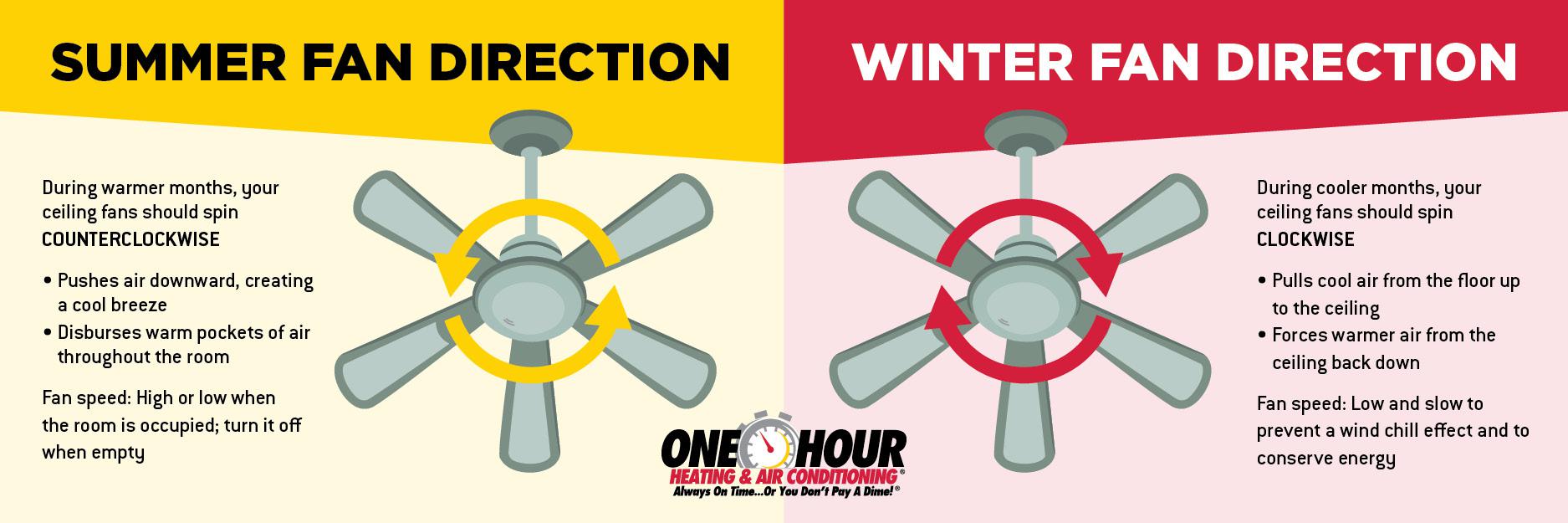Ceiling Fan Direction: Winter vs. Summer
Does changing the direction of your ceiling fan have your head spinning? Here's everything you need to know.
TL;DR – Ceiling Fan Direction
- During the colder months (winter), your ceiling fan should spin clockwise.
- During the warmer months (summer), your ceiling fan should spin counterclockwise.
- Most ceiling fans have a small switch on the fan body to control the spinning direction.
- Fans at low speeds will pull cold air upward more efficiently.
- Fans at high speeds create a cooling wind chill effect.
Ceiling Fan Direction in Winter
During the cold winter months, your ceiling fan should spin clockwise. Fan blades turning clockwise will cause an updraft that pulls cold air upwards. Because cold air is denser than warmer air, this will push warm air back down towards the floor where you can feel and enjoy it. Why not enjoy the air you're paying to heat?
Ceiling Fan Direction in Summer
Switch the direction of your ceiling fan to spin counterclockwise once the weather warms up. The blades' angle pushes air back toward the floor, creating a cooling breeze that also prevents a pocket of warm air from gathering near the ceiling. This keeps warm and cool air moving and lowers the average air temperature in the room by a degree or two.
According to the Department of Energy, switching your ceiling fan to the summer direction can make the room feel up to 4 degrees cooler. Not only can you raise your thermostat settings a few degrees, but you might also be able to skip the AC altogether on mild days. Think a few degrees won't add up? Changing your thermostat by 1 degree can impact your energy bill by about 3%!

How Much Energy Does a Ceiling Fan Use?
Running a ceiling fan uses between 15 and 90 watts, depending on the model, the speed setting, and the materials it is made from. On average, ceiling fans use about as much as a standard light bulb, which makes investing in a ceiling fan a smart move. If installing or upgrading your fan, always look for Energy Star-certified models, which can be up to 60% more energy efficient than non-certified alternatives.
For more energy efficiency tips, check out our Complete Guide to HVAC Energy Efficiency.
How to Change Ceiling Fan Direction
- From the fan. Nearly every ceiling fan has a small switch on the fan body to control the spinning direction. Make sure you turn the fan off, then use a step ladder to access the fan's motor housing. The switch is usually a simple two-directional toggle. Push the switch down for counterclockwise rotation (summer fan direction). Push the switch up for clockwise rotation (winter fan direction).
- From the wall panel. If your fan has a remote or wall panel, check to see if you can switch directions there first. Most will be labeled either "clockwise" or "counterclockwise," though some may use a graphic with arrows to indicate the directional settings.
- From your phone. Smart ceiling fans can be controlled from your mobile device! You can set some smart ceiling fan models on seasonal schedules, or they can even work automatically with your home’s smart HVAC system. Your local One Hour Heating & Air Conditioning technician will help you find the right equipment to bring this technology home.
Should My Ceiling Fan Spin Fast or Slow?
In the winter, keep your fan spinning at a low speed for two reasons:
- Fans at low speeds will pull cold air upward more efficiently.
- Fans at low speeds won’t cause a cooling wind chill effect.
In the summer, turn up the speed to create a wind chill effect. Turn the speed back down after the room cools or is unoccupied.
Should I Leave My Ceiling Fan on All the Time?
No, and there's a good reason not to. Ceiling fans don't actually change the temperature of the room. The movement of air only changes how warm or cold occupants feel. Once you walk out of the room, leaving the fan is not beneficial; turn it off, along with the lights, to save energy. Need to upgrade your fan? Ask your local Mister Sparky about ceiling fan installation.
Related: What is More Expensive, Heating or Cooling?
Homes with Vaulted or Cathedral Ceilings Benefit More
Changing your ceiling fan direction seasonally is especially helpful if your home has high or “vaulted” ceilings. The added room height allows more warm air to rise, so your heating system works harder to maintain your thermostat setting. Homes with high ceilings benefit from running their fans whenever the heating system is running to ensure even distribution of warm air.
A New Spin on Home HVAC Service
Knowing the best winter ceiling fan direction for energy efficiency is just one way to lower your home heating costs and keep your family comfortable. Trust your local One Hour Heating & Air Conditioning team to offer the most professional maintenance, repair, and installation services whenever your HVAC system needs an expert touch. Request an appointment or call (800) 893-3523 today.
